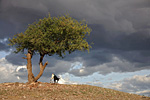Information about world heritage sites and other
historic sites in the Gambia.
UNESCO World Heritage sites in Gambia
Kunta Kinteh Island and Related Sites
World heritage site located in Banjul and other
parts of the Lower Niumi and Upper Niumi Districts
of Gambia. Received UNESCO Cultural World Heritage Site
status in 2003. Features sites along the River Gambia related to
encounters between Africans and Europeans along
the River Gambia, including the pre-colonial period,
the pre-slavery period, the slavery period, and
Gambia achieving independence. The seven sites with
world heritage status include?
- Kunta Kinteh Island (aka James Island)
- Albreda Village (chapel and warehouse)
- Juffureh Village (Maurel Freres Building)
- Sao Domingo Portuguese Settlement Remains
- Fort Bullen and the Six-Gun Battery
-
UNESCO "Kunta Kinteh Island and Related Sites" Profile
-
Wikipedia "Kunta Kinteh Island" Article
Stone Circles of Senegambia
Four large groups of stone circles and more then
1000 monuments in a section along 350 kilometers
of the Gambia River that is about 100 kilometers wide.
-
UNESCO "Stone Circles of Senegambia" Profile
-
Wikipedia "Senegambian Stone Circles" Article
More about Historic Sites in the Gambia
Kunta Kinteh Island
Located about 30 kilometers inland
from the mouth of the River Gambia.
Designated a world heritage site in 2003.
Known as "James Island" until February 6, 2011
when it was given he Gambian name "Kunta Kinteh Island".
Fort Bullen
Built in 1827 after the James Island Fortress
was destroyed by the French. Located
on the Northern end of barra Pont. Named
after British Commodore Charles Bullen.
Fort James
Remains of a fort on Kunta Kinteh Island in
the Gambia River. Designated a world heritage site in 2003.
Located near Juffure in the Upper Niumi District
of Gambia, about 19 miles from the Atlantic coast
mouth of the River Gambia.
-
Fortified Places: James Island Fort
-
Love Gambia: Fort James Island
Six Gun Battery
Artillery battery with 24 pounder guns
established to apprehend
American, French, Portuguese, and Spanish
slave trading ships after the British Abolition
Act of 1807 made slave trafficking illegal.


